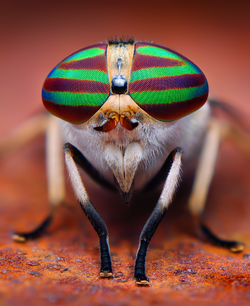Tabanidae
| Vernacular names | |
|---|---|
| • Deutsch: | Bremsen |
| • English: | horse flies deer flies |
| • Español: | tabánidos |
| • Français: | mouches à chevreuil |
Tabanidae - (horse and deer flies)
The family of Tabanidae is widely distributed and contains more than 4,000 species of medium-sized to large flies. They are excellent fliers. The females suck blood from humans, livestock and other mammals, whereas the males feed on nectar. Bites are often painful and several species mechanically transmit diseases (e.g. filariasis or tularemia). In some areas, horse flies can be so numerous and aggressive that they disrupt the outdoor activities of humans. The larvae live in moist soil or under stones and feed on organic matter, worms or insect larvae.
Larger species are called horse flies (10-30 mm long) and smaller ones deer flies (6-10 mm long). The adult flies are stout, without bristles, often darkly coloured and with large eyes. The eyes of some species have iridescent and brilliantly coloured bands.
For details see the respective page in Wikipedia. For a taxonomic review of the family see Morita et al., 2016.
The following genera and individual species are currently entered in the system:
